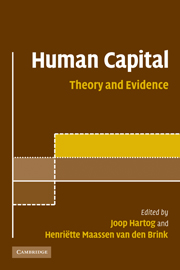Book contents
- Frontmatter
- Contents
- List of figures
- List of tables
- Notes on contributors
- Prologue
- Part I Measuring the benefits from human capital
- Part II Applying and extending the human capital model
- Part III Policy interventions
- 10 Using (quasi-)experiments to evaluate education interventions
- 11 Unemployment duration: policies to prevent human capital depreciation
- 12 Can We stimulate teachers to enhance quality?
- 13 Optimal tax and education policies and investments in human capital
- Epilogue: some reflections on educational policies
- A note on econometrics
- Index
- References
13 - Optimal tax and education policies and investments in human capital
Published online by Cambridge University Press: 22 September 2009
- Frontmatter
- Contents
- List of figures
- List of tables
- Notes on contributors
- Prologue
- Part I Measuring the benefits from human capital
- Part II Applying and extending the human capital model
- Part III Policy interventions
- 10 Using (quasi-)experiments to evaluate education interventions
- 11 Unemployment duration: policies to prevent human capital depreciation
- 12 Can We stimulate teachers to enhance quality?
- 13 Optimal tax and education policies and investments in human capital
- Epilogue: some reflections on educational policies
- A note on econometrics
- Index
- References
Summary
Introduction
When one starts to think about schooling and training as investments in human capital, one realizes that public policies are particularly important for the incentives to acquire human capital. First of all, progressive taxes on labour income, taxes on capital income and taxes on consumption are major sources of government revenue. Furthermore, a large part of taxation is used for social insurance and redistributional purposes. In 2006 the total tax and non-tax revenue in OECD countries amounted about 38% of GDP (Netherlands: 49%) (see OECD 2005). Clearly, taxation affects the economic incentives to acquire skills in various ways. Education is highly subsidized by most governments. Public contributions to the direct costs (school buildings, teachers’ wages, etc.) are substantial. In OECD countries governments contribute about 87% to the direct costs of education (Netherlands: 93%). Average public spending on education in OECD countries is about 4.6% of GDP (Netherlands: 4.3%) (see OECD, 2003). Furthermore, outlays on education are among the most important public spending categories of most governments. Clearly, the government must have important motivations to subsidize education to this large extent.
Brief review of the literature
After some important early studies on taxation and human capital formation (Boskin, 1975; Heckman, 1976; Kotlikoff and Summers, 1979; Eaton and Rosen, 1980; Driffil and Rosen, 1983), theoretical interest remained somewhat slack for a decade or so until endogenous growth theories came to the fore.
- Type
- Chapter
- Information
- Human CapitalAdvances in Theory and Evidence, pp. 212 - 232Publisher: Cambridge University PressPrint publication year: 2007
References
- 2
- Cited by



